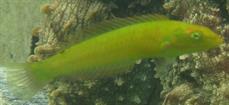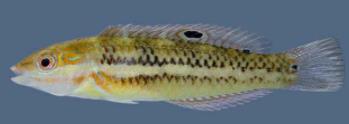



Halichoeres poeyi
| Ecological Descriptors |
||||
| Habitat | Size (cm) | Diet | Behaviour | Sex |
| S | 20 | Cru, Mol, Ech | Sh, Ter | PGH |
General:
Many wrasses are protogynous hermaphrodites, with some Initial Phase (IP) females, turning into Terminal Phase (TP) males once they reach a certain size, although there are often IP males in many species (diandrony).
Description:
Note:: Despite the name, this species does not have a "black ear", but rather a black spot towards the rear of body on upper side ("black rear"!).
Terminal Phase: Adult males are dull green, the centers of the scales with a dull orange red spot; caudal fin with a median longitudinal and upper and lower diagonal converging blue-edged rose bands. A small black spot at rear base of dorsal fin. orange to purplish spot behind eye
Initial Phase: Small individuals yellowish green with a orange to purplish spot behind eye; a small black spot at rear base of dorsal fin. Orange/ spot behind eye.
Juvenile: Pale, whitish shades with 4 dark bands on upper body and dark spot mid way along dorsal fin
Ecology
Commonly found in clear seagrass beds; uncommon on reefs or muddy bays. Depths of 0-50m (0-160ft). This species is strictly diurnal in nature and is lethargic during the hours of darkness. It feeds mainly on invertebrates such as decapods, gastropods, sea stars and sea urchins, it is assumed that sea urchins are scavnged after they are predated by larger predatory fish. H. poeyi is the only species of Halichoeres where the larvae develop internal, specialised, chromatophores.
Life Cycle:
Diandric - possessing two different types of males, a large, brightly-coloured and aggressive terminal phase (TP) which has changed sex from an IP female (protogynous hermaphrodite - Length at sex change = 8.3 cm ), and a smaller, drab and relatively non-aggressive initial phase male(IP). The TP has priority access to food and spawning females. On the death or removal of a TP, the first-ranking IP female becomes the next TP male (after first checking the reef thoroughly to make sure the TP is gone).
TP males form leks during breeding. IP males group spawn or sneak in on TP males spawning with females (a strategy known as "streaking").
Many wrasses are protogynous hermaphrodites, with some Initial Phase (IP) females, turning into Terminal Phase (TP) males once they reach a certain size, although there are often IP males in many species (diandrony).
Description:
Note:: Despite the name, this species does not have a "black ear", but rather a black spot towards the rear of body on upper side ("black rear"!).
Terminal Phase: Adult males are dull green, the centers of the scales with a dull orange red spot; caudal fin with a median longitudinal and upper and lower diagonal converging blue-edged rose bands. A small black spot at rear base of dorsal fin. orange to purplish spot behind eye
Initial Phase: Small individuals yellowish green with a orange to purplish spot behind eye; a small black spot at rear base of dorsal fin. Orange/ spot behind eye.
Juvenile: Pale, whitish shades with 4 dark bands on upper body and dark spot mid way along dorsal fin
Ecology
Commonly found in clear seagrass beds; uncommon on reefs or muddy bays. Depths of 0-50m (0-160ft). This species is strictly diurnal in nature and is lethargic during the hours of darkness. It feeds mainly on invertebrates such as decapods, gastropods, sea stars and sea urchins, it is assumed that sea urchins are scavnged after they are predated by larger predatory fish. H. poeyi is the only species of Halichoeres where the larvae develop internal, specialised, chromatophores.
Life Cycle:
Diandric - possessing two different types of males, a large, brightly-coloured and aggressive terminal phase (TP) which has changed sex from an IP female (protogynous hermaphrodite - Length at sex change = 8.3 cm ), and a smaller, drab and relatively non-aggressive initial phase male(IP). The TP has priority access to food and spawning females. On the death or removal of a TP, the first-ranking IP female becomes the next TP male (after first checking the reef thoroughly to make sure the TP is gone).
TP males form leks during breeding. IP males group spawn or sneak in on TP males spawning with females (a strategy known as "streaking").
Blackear Wrasse IP
Blackear Wrasse
Juvenile
Juvenile


149

Blackear Wrasse TP











Blackear Wrasse TP
507



(C) Kevin Bryant
(C) Van Tassell

